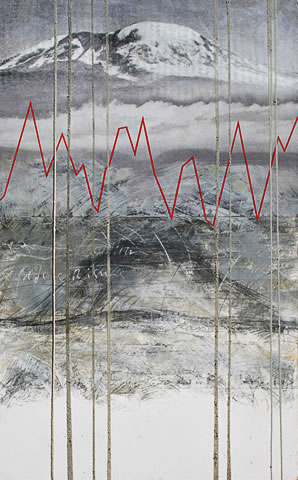Main Gallery
Georgia Papageorge
Kilimanjaro/Coldfire
26th October – 22nd December, 2010
Left: Kilimanjaro – Southern Glaciers, 1898, 2010, mixed media on canvas, with inkjet print taken from the earliest known photograph of the glaciers, and lines of poured ash from the ash cone of Kilimanjaro itself, 230 x 140 cm
Right: MKAA III, 2008, installation with bags of charcoal and red chevroned banners, Northern Tanzania September 2006, Lightjet prints on Fuji Crystal archival paper, 230 x 110 cm
The mountain that came to be known as Kilima 'njaro' (Mountain of Greatness) is the tallest freestanding volcanic mountain in the world, with a unique, self-contained ecological system that makes it an ideal barometer of climate change. Papageorge's renderings of Kilimanjaro, in which she applies vertical striations of poured volcanic ash - running tears for an irreparable loss - transform it into an iconic African symbol of mourning.
When Papageorge first saw Mount Kilimanjaro in Tanzania, its domed summit of snow and ice appeared to float in a sublime sphere of its own, separated by cloud and atmosphere from the earth. Since then she has climbed the mountain on four occasions and undertaken two crater flights, one in 1997, and one more recently in 2007, when she was accompanied by a photographic team working on the film for this exhibition.
Kilimanjaro/Coldfire is the fourth in a series of major African land art projects which Papageorge has worked on since 1994. A powerful group of works shows Kilimanjaro with a crisp red temperature line moving across their surfaces to demonstrate an analysis of glacial melt. The southern glaciers reveal increasing expanses of volcanic rock as the ice continuously melts away. This process has a visual record going back as far as 1898, from the oldest known photograph, and continues in this exhibition with Papageorge's first encounter in 1996, moving on to the present.
The geological and sociological sense of schism or rift within Africa and indeed the rest of the world, increasingly asserted itself in the artist's consciousness. She explores this as a key metaphor in her art. Eventful journeys undertaken from Pretoria up the Great East African Rift Valley to Tanzania and back in 2006 and 2007, provided Papageorge with such shocking fresh evidence of the effects of climate change as well as the highly illegal and dangerous charcoal trade that is carried out in most Central African countries, that her focus shifted from earlier ideas about transcendence, to the urgent matter of documentation.
Besides the ash pour trilogy, this exhibition includes two photographic towers which present different analyses of Kilimanjaro's southern ice field; one piece is compiled of photographs taken over a period of 70 years by people living in the vicinity, the other comprises photographs taken from General Smuts's cine film, made when he flew over Kilimanjaro to Egypt in 1943 on a trip to inspect South African forces based there. These, like everything in Kilimanjaro/Coldfire, become witness to something of great natural beauty, but with tragic overtones.
An installation piece, MKAA IV leads us to the film made over the past 18 months. Alongside the paintings and mixed media works, this film is critical to understanding the compelling story underlying the exhibition.
Coldfire is no longer a conceptual contradiction. Through assembled fact and photographic evidence, Papageorge is an African artist who has experienced at first hand what many of us may have read about only in passing. Her passionate, symbolic and emotionally charged work insists that we now pay attention.











